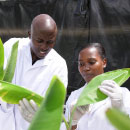Seed for vegetatively propagated crops is generally sourced locally, often must be fresh, and is not usually sold on the market.
However, while the need for good seed systems is accepted by policymakers, the special characteristics of vegetatively propagated crop seed has sometimes resulted in interventions to strengthen seed systems that do not live up to their promise. In order to better understand root, tuber and banana seed systems, RTB developed a multistakeholder framework that identifies the different roles of stakeholders in seed systems and how they relate to each other. By doing so, it can be used to improve seed interventions.
Production of seed for roots, tubers and bananas involves a wide range of stakeholders who must coordinate their activities and have aligned goals if the system is to operate effectively. Ideally, all stakeholders would agree about what quantities and varieties are needed by whom, timing of supply, marketing, quality regulation and many other factors. When this does not happen, a breakdown in coordination can mean that the needs of particular users are ignored. For example, regulatory agencies and specialized seed producers in the formal seed sector may not appreciate the specific needs of women seed users.
RTB applied the multistakeholder framework to analyze 13 different interventions, ranging in size from purely local to multi-national, at a series of five workshops. Lessons learned covered a range of outcomes.

In Tanzania, a project wanted to support women to become specialized suppliers of sweetpotato vines, because sweetpotato is largely a women’s crop. In the end, 75% of the farmers trained to be individual vine multipliers (by the largely male staff of NGOs and extension services) were men. The framework identified three coordination failures: seed production could not be timed to match peak demand, because rainfall was unpredictable; quality proved hard to maintain as scaling ramped up, perhaps too quickly; and the limited life of the project was not long enough to cement linkages among stakeholders.
In Ecuador, the cost of certified potato seed proved prohibitive to an organization of smallholder farmers, so RTB worked with them to produce their own quality declared seed, multiplied from government certified seed, for sale to members. The farmers created their own standard for quality declared seed, which was then incorporated into Ecuador’s seed quality regulations, thanks to discussions that aligned the government’s desire to maintain seed quality with the farmers’ need for lower-cost seed that would still be of acceptable quality.
In Kenya, a project trained 20,000 farmers to use new potato seed and keep it healthy for a couple of years. At the same time, specialist seed producers were encouraged to invest in very high quality foundation stock and grow clean seed in open fields, increasing the supply and lowering the cost. This clean seed found a ready market among the 20,000 trained farmers, half of whom were women. Thanks to the reduced cost of clean seed, women could afford to buy it for the first time and so reap the benefits of high-quality seed.
A review of the framework as applied to the case studies reveals many other examples of the ways in which coordination among all stakeholders, from government regulatory agencies through to final seed users, can result in more successful interventions. One of the most important refinements that the framework identified was to ensure a gender-integrated analysis with the different seed systems stakeholders, because even within a single type of stakeholder, women’s interests may conflict with men’s.








